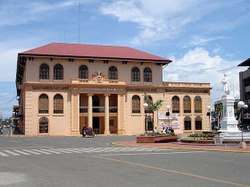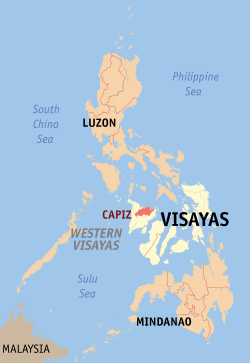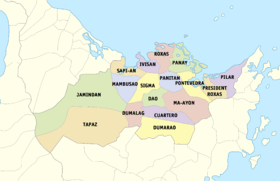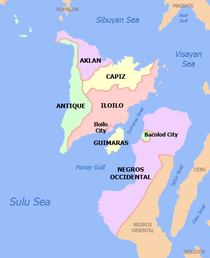Capiz
Capiz (Capiznon/Hiligaynon: Kapuoran sang Capiz) is a province in the Philippines located in the central section of Western Visayas region. Its capital is the city of Roxas. It located in the central section and is located at the northeastern portion of Panay Island, bordering Aklan to the north, Antique to the west, and Iloilo to the south. Capiz faces the Sibuyan Sea to the north.
Capiz | |
|---|---|
| Province of Capiz | |
 Capiz Provincial Capitol | |
 Flag .png) Seal | |
| Anthem: O, Capiz | |
 Location in the Philippines | |
| Coordinates: 11°23′N 122°38′E | |
| Country | Philippines |
| Region | Western Visayas (Region VI) |
| Discovered | 1566 |
| Encomienda | 1569 |
| Politico-Military Province | 1716 |
| Founded | April 15, 1901 |
| Capital | Roxas |
| Government | |
| • Type | Sangguniang Panlalawigan |
| • Governor | Esteban Evan B. Contreras (PDP-Laban) |
| • Vice Governor | James "Mitang" O. Magbanua (NUP) |
| • Electorate | 513,329 (2019)[1] |
| Area | |
| • Total | 2,594.64 km2 (1,001.80 sq mi) |
| Area rank | 52nd out of 81 |
| Highest elevation | 2,073 m (6,801 ft) |
| Population (2015 census)[3] | |
| • Total | 761,384 |
| • Rank | 38th out of 81 |
| • Density | 290/km2 (760/sq mi) |
| • Density rank | 25th out of 81 |
| Divisions | |
| • Independent cities | 0 |
| • Component cities | 1
|
| • Municipalities | |
| • Barangays | 473 |
| • Districts | 1st and 2nd districts of Capiz |
| Time zone | UTC+8 (PST) |
| ZIP Code | 5800–5816 |
| IDD : area code | +63 (0)36 |
| ISO 3166 code | PH-CAP |
| Spoken languages |
|
| Website | capiz |
Capiz is known for the Placuna placenta oyster shell that has the same name locally and is used for decoration and making lampshades, trays, window and doors. Likewise, the province is known as the "Seafood Capital of the Philippines"[4] and was among the top 15 most frequently visited places in the Philippines.[5] Capiz is the site of the famous coral-stone Santa Monica Church in the town of Pan-ay, home to the largest Catholic Church bell in Asia. The bell was made from 70 sacks of gold and silver coins donated by the townsfolk. Measuring seven feet in diameter, five feet in height and weighing 10,400 kilograms or just over 10 metric tons, the Pan-ay bell is popular among tourists visiting Capiz.
History
The account of early Spanish explorers about Capiz and its people was traced back in 1566 when the Spaniards set foot in the mouth of Banica river. Early settlements were seen in the town of Pan-ay which the town originally called "Bamban" which was changed by the early Spaniards to "Panay", a word which means "mouth of the river." This is also the location of a fortress built by Juan de la Isla in late 1570. The Paseo de Evangelizacion 1566 can be found in the town plaza and was erected through the efforts of Rev. Msgr. Benjamin F. Advincula.
When the Spaniards led by Miguel López de Legazpi came to Panay from Cebu in 1569, after sailing from Mexico, they found people with tattoos, and so they called the island Isla de los Pintados.[6] How the island itself came to be called Panay is uncertain. The Aeta (Negritos) called it Aninipay, after a plant that abounded in the island. Legend has it that López de Legazpi and his men, in search of food, exclaimed upon the island, pan hay en esta isla! "There is bread in this island"! and the island of Panay closely resembles the shape of a heart and the heart of Jesus Christ is considered present in the Eucharistic Bread. Panay is also an echo of Pannai, a constituent state in Srivijaya that housed an officially Buddhist Monastic-Army that defended the conflict-prone strait of Malacca, the world's busiest maritime trade route for half a millennium and had successfully defended the territory against larger navies from giant countries like India, China and Indonesia before a treacherous and unexpected attack from the Chola-occupied capital destroyed Srivijaya and sacked Pannai. Idealistic Datus and their most faithful soldiers who refused to submit to foreign imperialism left the golden chains they had in Sumatra and migrated to Panay island to rebuild a society much truer to their ideals and had even achieved more democracy since they developed their initial mandala even further, the original concept of the mandala being a dynamic interaction sphere based on Tantric cosmology and political thought, with a definite center and the Datus of Panay then expounded on that tradition and decided to make the Mandala resistant to destruction by making it into a Kedatuan, establishing a Semi-democratic Hindu-Buddhist influenced Confederation known as the Kedatuan of Madja-as where capitals and were routinely being transferred and different Datus took turns holding the crown. The Spanish then came and established their first settlement on the island at the mouth of the Banica River and called it Pan-ay. This was the second Spanish settlement in the Philippines, following San Miguel, Cebu. Unknown to many, Calle Revolución in Panay town is the second oldest street in the Philippines after Calle Colon in Cebu City, Central Visayas.
Later in 1569, Captain Diego de Artieda, who was sent by Legazpi, landed in the Town of Panay and proclaimed it as the capital of the province. Later, the Spaniards moved the capital to its present site upon discovering the town of Capiz (not the province, and now Roxas City) which was near the sea and provided docking facilities.
The province was created a separate encomienda and was later organized into a politico-military unit in 1716. The American takeover of the Philippines resulted in the establishment of a civil government in Capiz on April 15, 1901 by virtue of Act 115.[7]
The Panayanon's noble character and royal blood shone out in later centuries when fellow people from Panay island, at Iloilo City was given the Queen of the Spain, the Royal Title of "Most Loyal and Noble City" for being the most ardent and faithful city in the Spanish empire and had clung on to Spain while the entire empire collapsed. Although Capiz joined the Tagalog lead Philippine revolution, the Spaniards didn't surrender to the Tagalogs but they did surrender to the people of Iloilo and eventually Iloilo and Capiz were part of the same "Federal Republic of the Visayas" a substate which was formed within the First Philippine Republic, the first capital of which was in Cavite while the United States of America had betrayed the Philippine Revolution which they initially supported and in which, influential American officers swore loyalty to, by breaking their oaths and occupying Manila.
In 1942, the province was occupied by Japanese troops and was later liberated by the joint Filipino and American troops with Capiznon guerrillas in 1945.
Capiz and Aklan were united under one province until 25 April 1956, when President Ramon Magsaysay signed into law Republic Act 1414 separating the two entities.[8]
Geography

Capiz covers a total area of 2,594.64 square kilometres (1,001.80 sq mi)[9] occupying the northeastern portion of Panay Island, and is one of the five provinces that compose the Western Visayas region. Mount Nangtud, is the highest mountain in Capiz with an elevation of 6,800 ft ( 2,073 m) located in the Capiz-Antique border. Other peaks are Mount Tigas 4,760 ft (1,451m), Mount Agudo 2,736 ft (834m). The province comprises 473 barangays, 16 municipalities and a city. Roxas City, the provincial capital, is only 45 minutes away by plane from Manila and is within the routes of major shipping lines. The Panay River used to be famous for the great number of crocodiles thriving there. Capiz is bounded by the Sibuyan Sea, the Panay, Loctugan and Ivisan rivers.
Administrative divisions
Capiz comprises 1 city (Roxas) and 16 municipalities, further subdivided into 473 barangays, with 2 congressional districts.
- † Provincial capital and component city
- Municipality
| ||||||||||||||||||||||||||||||||||||||||||||||||||||||||||||||||||||||||||||||||||||||||||||||||||||||||||||||||||||||||||||||||||||||||||||||||||||||||||||||||||||||||||||||||||||||||||||||||||||||||||||||||||||||||||||||||||||||||||||||||||||||||||||||||||||||||||
Demographics
| Year | Pop. | ±% p.a. |
|---|---|---|
| 1980 | 492,231 | — |
| 1990 | 584,091 | +1.73% |
| 1995 | 624,469 | +1.26% |
| 2000 | 654,156 | +1.00% |
| 2007 | 701,664 | +0.97% |
| 2010 | 719,685 | +0.93% |
| 2015 | 761,384 | +1.08% |
| Source: Philippine Statistics Authority[3][10][10] | ||
The population of Capiz in the 2015 census was 761,384 people,[3] with a density of 290 inhabitants per square kilometre or 750 inhabitants per square mile.
Inhabitants
Historians and ethnologists narrowed down to three types of people known to have inhabited Capiz: Atis/Aetas, popularly known as Negritos; Indonesian descendants of the Mundo tribe in central Panay; and the Malays.
Sulod tribe
Located in Tapaz, it is a cultural minority of Indonesian stock that worships spirits, practice secondary burial, and hunt with blowguns. The Sulod love personal ornaments. The necklace worn is not only an ornament and a status symbol but also an anting-anting or amulet.
Religion
Roman Catholicism remains influential in the lives of most people living in Capiz especially in the fields of politics, education and even in their daily personal decisions. Roman Catholics are predominant with 70 percent adherence, the Iglesia Filipina Independiente has a strong minority with 20 percent while other minorities are Born Again Christians, Iglesia Ni Cristo, Methodists, The Church of Jesus Christ of Latter-day Saints, Baptists, Jehovah's Witnesses, and Seventh-day Adventists among others.
Languages
There are two main local languages: Capiznon and Hiligaynon. English is also used and understood as a business language and is widely spoken as a second languages. Aklanon is spoken in towns near Aklan such as Sapian, Jamindan, and Mambusao.
Capiznon is concentrated in the province of Capiz in the northeast of Panay. It is a member of the Visayan language family and the people using it are part of the wider Visayan ethnolinguistic group, who constitute the largest Filipino ethnolinguistic group. It is related but often confused with Hiligaynon/Ilonggo, yet it has its own unique vocabulary and accent, as well as a handful of words unique to the language itself.
Economy
With its 80-kilometer coastline and wide expanse of swampy lands easily converted into fishponds, Capiz is dubbed as the "Seafood Capital of the Philippines". It holds one of the richest fishing grounds and is a major contributor in the aquamarine industry of the Philippines. Farming and fishing are the primary sources of income for the people. The combined natural bounty of land and sea sustain a vibrant food industry. Primary agricultural raw products are rice, corn, coconut, sugarcane, banana and cut flower.
Apart from a surplus of agricultural products, Capiz is also a major supplier of prawn and milkfish (bangus). Other agro-industrial harvests include blue marlin, squid, oysters, shrimp, seaweed, and angel wings. Rich fish ponds attract investors to venture into prawn culture, prawn feed manufacture, seaweed farming and the distribution and processing of other marine products. A robust workforce of 445,246 operates with a literacy rate of 92.04%. Its relatively unexplored caves are said to have high deposits of mineral resources such as limestone, gold and metal.
Telecommunications
Four big telecommunication companies offer telegraph, telex and telephone services. Communication facilities are catered by the Philippine Long Distance and Telephone Company (PLDT), Bureau of Telecommunications (BUTEL), PT&T, RCPI-Bayantel, Globelines-Islacom and cellular phone companies: Smart, Globe, Touch Mobile & Sun Cellular. Internet services are also available like PLDT Vibe.
Broadcast communications
Broadcast media is catered by 4 radio stations namely: AM - DYJJ, DYOW - Bombo Radyo, DYVR - Radio Agong / RMN - FM.-Star FM, Love Radio, and Radyo Todo. Television facilities reach the city through Iloilo. However, we have two (2) cable television provided by Wesfardell Cable Services and the Filvision, Inc. (Altocable). An ABS-CBN Television relay station is now operating in the city.
Banks
There are more than 60 banking institutions and 116 intermediaries operating in the province.
Capiz products
Some popular Capiz shell chips decorating design include gift items, indoor decoration and outdoor decoration ornaments. Capiz chip-made products range from lanterns, lamp shades, window pane, chandeliers, curtains, picture panels and frames, Capiz shell balls, plates, decorative bowls, candle holders, tiles, flower vase, door hanging chime, soapdish, pendant, globelight, necklace decor, beads, bird cage, floor lamp holders, faux chandelier, gift boxes, collection item rack and many more.
Bulad or dried fish is a major product. There are several varieties of dried fishes that can be found in Capiz.
Business Process Outsourcing
The province has currently one non-voice outsourcing company - PETRA Academy. PETRA Academy serves Korean nationals for an online English tutorial. The company is located in 3/F JC TIU Building, Corner Burgos Street and Inzo Arnaldo, Roxas City. Pueblo de Panay township has allotted 7 hectares for Pueblo de Panay Technopark. The PEZA-approved technopark will house international and national BPO companies soon.
Culture
Capiz is known for its trademark product, the brilliant Capiz shell, used in windows, lanterns, decorations, vases, etc. The Capiz shell has a luster similar to mother of pearl shells.
Hymn
The province has a good hymn, Titled Capiz, it was the story of Kapitan Diego who was mandated by Legazpi. From Cebu, Diego sailed to Capiz and reach the shore of Culasi. And he met the pintados(people with Tattoos) then later on named it Capiz(Roxas City) As the capital of Pan-ay.
But in 2006 theres a hymn actually won the contest. Titled O'Capiz.
Folk dances
Capiz is one of the places in the Philippines that contributed a lot in Philippine folk dancing. The province alone has 19 Visayan folk dances such as "Tinolabong", "Gayong-gayong", "Timawa", Dagit-dagit", "Beneracion", "Tatay Meroy Cariñosa", "Pukol", "Habanera Capiceña", "Cabatingan", "Saad", "Pitik Mingaw", "Kuratsa Capiceña", and "Palomita Coquitana" to name a few.
Festivals
- Saot Capiz - A cultural presentation - The First Capiz Dance Season held every Saturday at the Capiz Provincial Park, Roxas City.
- Sinadya sa Halaran - Is a merging of the Roxas City Fiesta "Sinadya" and the Province celebration of "Halaran". "Sinadya sa Halaran" is a commemoration of the feast of the patroness of Roxas City which is the Immaculate Conception and a thanksgiving. It literally means "Joy in Sharing and Thanksgiving". Rituals and festivities include fireworks, grand parades, fluvial processions, fair and food festivals, street dancing, and exhibits. Later, the festival was renamed "Sinadya sa Inmaculada Concepcion" with the dissolution of the Halaran Festival and the re-direction of the City's celebration to its patron, the Immaculate Concepcion. The City of Roxas, to celebrate the organization of its government, now also celebrates "Sugilanon Festival" in May of every year, usually in the week leading to or after May 12 which is the charter day of the city.
- Pangahaw Festival - A thanksgiving for a bountiful harvest by the Indigenous Peoples of Jamindan.
- Guyum-Guyuman Festival - "Caguyuman" the old name of Pontevedra, meaning anthill, a name distinct for ants' house was once a part of the municipality of Pan-ay mainly because of its abundant natural resources both from the coastal and upland areas. People from the nearby municipalities of Panay, Panitan, Maayon and President Roxas, would thrive in the market place like swarm of ants for trading. This rich tradition is now a celebration of life and thanksgiving for all Caguyumanons.
- Talahong Festival - Talaba and tahong is very rich in production in these areas. More than a hundred fisherfolk live along the coast. Since Sapian is abundant with seafoods, it was the initiative of the Local Government Unit to organize a Talahong Festival (Talaba-Tahong) every 2nd Friday and 2nd Saturday of May that promotes the local products.
- Tagbuan Festival - It was conceptualized during the Pre-Spanish time, wherein there were aetas in the upland barangay.
Transportation
Air
Roxas Airport is an airport serving the general area of Roxas City, the provincial capital. The airport is classified as a Class 1 principal airport, by the Civil Aviation Authority of the Philippines. Roxas Airport has 3 flights daily and 4 flights on selected days courtesy of Philippine Airlines, Cebu Pacific and Tiger Air Philippines.
Land
The primary transportation vehicle used in Roxas City and other municipalities in Capiz is the tricycle. Travel between municipalities is typically by jeepney, vans and Ceres operated buses. "Capiz Cab", the city's taxi that plies Roxas City and the 16 municipalities of the Capiz. Capiz Cabs are the first receipt-issuing taxis in the Philippines apart from those operating out of the Ninoy Aquino International Airport.
Sea
Inter and provincial mobility of residents and their cargo is serviced by vans, buses and jeepneys. Sea transportation (cargo vessel) is served by Moreta Lines plying the route of Roxas to Manila. Roll On-Roll Off (Ro-Ro) are served by two (2) shipping companies namely Super Shuttle Roro 2 and 2GO to fetch passengers from Roxas City to Batangas City via Odiongan, Romblon. Inter-island shipping is also served from Roxas City to the following locations such as: Balud, Masbate; Mandaon, Masbate; Sibuyan Island, Romblon; Cadiz, Negros Occidental; Guimaras Island; and Estancia, Iloilo.
Notable people
This list includes people with roots from Capiz.
Politics
- Jocelyn Bolante, Politician who formerly served as an Undersecretary of the Department of Agriculture of the Philippines.[11]
- Pedro Gil, was a physician, journalist, and legislator. He was elected representative for the south district of Manila on the Democratra party ticket. He became Minority Floor Leader in the House of Representatives of the Philippines.
- Manuel Roxas, first President of the independent Republic of the Philippines.
- Gerardo Roxas, Philippine Senator and son of President Manuel Roxas.
- Manuel Roxas II, Philippine Senator, grandson of President Manuel Roxas and former Department of Interior and Local Government (Philippines) secretary.
- Gerardo Roxas, Jr., grandson of President Manuel Roxas and former Congressman.
- Fredenil Castro, former deputy speaker of the House of the Representatives of the Philippines.
- Roy Señeres, Filipino statesman and diplomat.
- Antonio Trillanes, a retired Navy officer currently serving as a senator of the Philippines. Her mother is from Ivisan, Capiz.[12]
Sports
- Jeckster Apinan, a professional basketball player[13]
- Mac Belo, basketball player. A son of a Capiznon from Pan-ay, Capiz who migrated to Cotabato.[14]
- Jose Maxian, World Boxing Council (WBC) champion in the super featherweight International Youth[15]
- Glenn Peter Yap, shooting forward and number 8 overall pick of Alaska Aces in the 2000 Philippine Basketball Association (PBA) annual draft[16]
Entertainment
- Gina Alajar, actress and director. She was born in Lanot, Roxas City, Capiz.
- Charlie Davao, actor, he was born to Estrella Valdez of Capiz.[17]
- Ricky Davao, actor and director.
- Bing Davao, actor.
- Ryan Eigenmann, actor and son of Gina Alajar.
- Geoff Eigenmann, actor, brother of Ryan Eigenmann, son of Gina Alajar.
- Daisy Avellana, actress and theater director.[18]
- Barbie Almabis-Honasan, Singer, former frontman of Hungry Young Poets and Barbie's Cradle.
- Maria Margarita Moran Roxas - Floirendo - Bb. Pilipinas-Universe 1973, Miss Universe 1973 winner. A granddaughter of former Philippine President Manuel Roxas, she has also been known as Margie Morán Róxas and later as Margie Morán Róxas De Floirendo or simply Margie Morán. She was the last Philippine representative to the Miss Universe Pageant to bring home the crown until Pia Alonzo Wurtzbach 42 years later in 2015.
- Geraldine Villarruz Asis - Bb. Pilipinas-Universe 1987, Miss Universe 1987 finalist.
- Sharmaine Arnaiz was born Sharmila Velasco Pribhdas-Shahani to an Indian father and a mother from Legaspi St., Roxas City. She has a younger sister who is also an actress named Bunny Paras and their mother is the sister of the mother of Patrick Garcia and Cheska Garcia.
- Jovita Fuentes, Dubbed the First Lady of Philippine Music. The first female recipient of the National Artist Award.[19]
- Edu Manzano, actor, politician and endorser. His mother is from Roxas City.
- Luis Manzano, actor, host and endorser. His paternal grandmother is from Capiz.
- Jo Berry, actress, famous for her role as a mom with dwarfism on Onanay. Her mom is from Capiz.
- Mikoy Morales, actor, finalist of Protege: The Battle For The Big Artista Break
Media
- Paolo Bediones is a Filipino commercial model, television host, journalist, newscaster and radio announcer.
- Kara David, television host and journalist whose grandmother is a Capiznon.
Medicine
- Vicki Belo, well-known dermatologist, daughter of Enrique “Ike” Belo of Pan-ay Capiz[20]
Social sciences
- Josepha Abiertas, feminist and lawyer was born and raised in Capiz.[21]
See also
- Capiznon people
- Capiznon language
- Suludnon people
- Igbok language
References
- (PDF) https://www.comelec.gov.ph/php-tpls-attachments/2019NLE/Statistics/NumofRegVoterbySexbyCityMun.pdf. Missing or empty
|title=(help) - "List of Provinces". PSGC Interactive. Makati City, Philippines: National Statistical Coordination Board. Archived from the original on 11 January 2013. Retrieved 11 February 2013.
- Census of Population (2015). "Region VI (Western Visayas)". Total Population by Province, City, Municipality and Barangay. PSA. Retrieved 20 June 2016.
- "Welcome to Roxas City, Capiz, Philippines". www.roxascity.gov.ph.
- "More tourists visiting Capiz". Archived from the original on 10 August 2014. Retrieved 10 January 2014.
- "Archived copy". Archived from the original on 2016-03-04. Retrieved 2016-06-29.CS1 maint: archived copy as title (link)
- "Capiz now 109 years old". Philippine Information Agency. 14 April 2010. Retrieved 16 April 2010.
- "Republic Act No. 1414 - An Act to Create the Province of Aklan". Chan Robles Virtual Law Library. Retrieved 14 December 2015.
- "Province: Capiz". PSGC Interactive. Quezon City, Philippines: Philippine Statistics Authority. Retrieved 8 January 2016.
- Census of Population and Housing (2010). "Region VI (Western Visayas)". Total Population by Province, City, Municipality and Barangay. NSO. Retrieved 29 June 2016.
- "Pinoyfraternity.com". www.pinoyfraternity.com.
- https://www.senate.gov.ph/senators/sen_bio/trillanes_antonio_bio.asp
- "APINAN, Jeckster - PBA on INQUIRER.net". pba.inquirer.net.
- Corp, ABS-CBN. "MEET THE BELOS: Mac and Dr. Vicki finally meet!". ABS-CBN SPORTS.
- "Jose Maxian Captures The WBC Youth Championship". BoxingScene.com.
- admin (12 February 2013). "Capiz's sports heroes remembered". Archived from the original on 7 November 2017. Retrieved 31 October 2017.
- "Archived copy". Archived from the original on 2016-10-18. Retrieved 2016-10-15.CS1 maint: archived copy as title (link)
- Cadiz, Gibbs (2013-05-13). "National Artist for Theater Daisy Avellana dies; 96". Philippine Daily Inquirer. Retrieved 2013-05-19.
- "Jovita Fuentes was born in the town of Capiz February 15, 1895". The Kahimyang Project.
- Sports, ABS-CBN. "MEET THE BELOS: Mac and Dr. Vicki finally meet!". ABS-CBN News.
- "A". Women of History. Retrieved 6 January 2013.
External links


- Capiz Provincial Government Website
- Philippine Standard Geographic Code
- Capiz News


